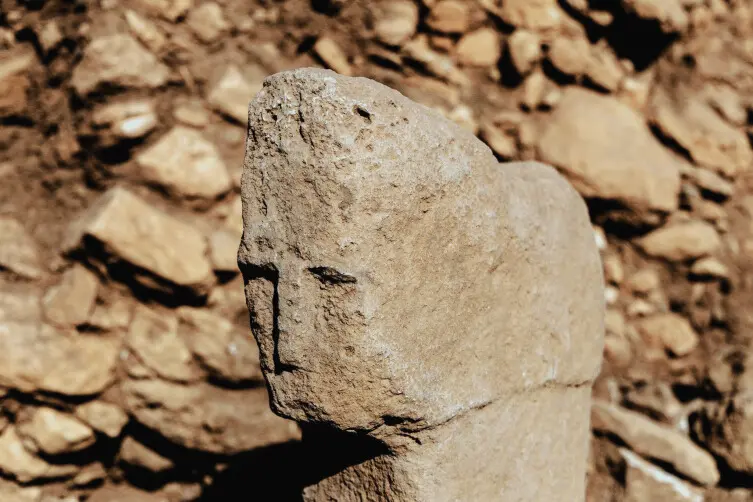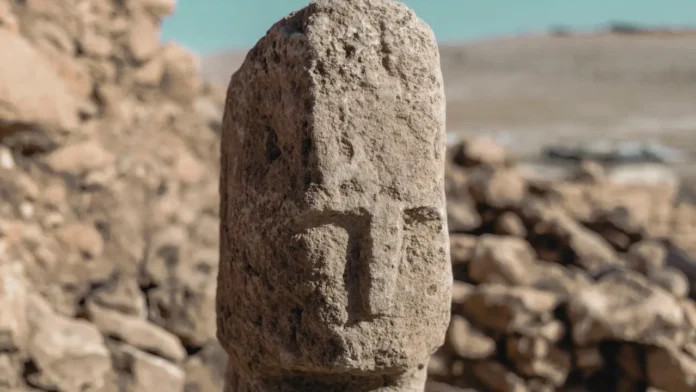Karahantepe Unearths 12,000-Year-Old Human-Faced Standing Stone
Archaeologists have revealed a groundbreaking discovery at Karahantepe, part of the Taş Tepeler Project, led by the Turkish Ministry of Culture and Tourism. For the first time, a T-shaped standing stone featuring a carved human face has emerged, dating back approximately 12,000 years. This discovery marks a significant milestone in the study of Neolithic symbolic art and early human representation.
A Face from the Distant Past
Previously, the T-shaped standing stones at Göbeklitepe and surrounding sites were known for their intricate carvings of arms and hands, suggesting these monuments symbolized humans. However, the Karahantepe find is unique: it directly depicts facial features on the T-shaped stone, providing the earliest known example of human self-representation in this form.
According to the Ministry of Culture and Tourism, the newly discovered stone exhibits sharp facial lines, deep eye sockets, and a broad nose, reminiscent of other Neolithic sculptures found in the region. Experts suggest that this carving demonstrates not only technical skill but also abstract thought and self-expression among early humans.
First Direct Symbol of Humanity
For years, researchers believed that T-shaped stones served primarily as symbolic or structural elements within sacred complexes. The Karahantepe human-faced stone now suggests a deeper purpose: the stones were used to depict humans in a more direct and personal manner, rather than merely abstract representations.
This breakthrough provides a new lens into Neolithic culture, illustrating how early humans explored identity, representation, and possibly social or spiritual hierarchies through stone art.

Taş Tepeler: Gateway to Human History
The Taş Tepeler Project encompasses multiple archaeological sites in southeastern Turkey, including Göbeklitepe, Karahantepe, Sayburç, Sefertepe, and Harbetsuvan. These sites collectively reveal the transition to settled life, early religious practices, and the development of symbolic art.
At Karahantepe, 2025 excavation efforts across ten different areas have already yielded numerous human and animal sculptures. The human-faced T-shaped stone adds a significant chapter to our understanding of the Neolithic era, highlighting how early societies expressed themselves symbolically.
Insight into Neolithic Expression
The facial carving on the T-shaped stone is not just decorative. Scholars argue that the work represents a sophisticated level of abstract thinking and self-awareness. Unlike mere symbolic gestures, the carving communicates individuality and identity, marking an early form of artistic and cultural expression.
“The distinct facial features—sharp lines, deep eye sockets, and a broad nose—connect this piece to other Neolithic sculptures, confirming a shared artistic language in the region,” says a leading archaeologist from the Taş Tepeler Project.
Symbolism, Architecture, and Belief
T-shaped standing stones in the region have long been interpreted as both architectural supports and sacred symbols. The new discovery strengthens the idea that these stones conveyed complex cultural and spiritual meanings, reflecting the beliefs and worldview of Neolithic humans.
This find emphasizes that the Neolithic era was not only about survival but also about expressing identity and understanding humanity’s place in the cosmos.
Karahantepe: A Center of Early Human Thought
The human-faced T-shaped stone situates Karahantepe as one of the earliest cultural centers where humans attempted to interpret their existence. The discovery also demonstrates the continuity of human creativity, showing that 12,000 years ago, people were already exploring the concept of self and artistic expression.
For those interested in the broader project, Göbeklitepe offers additional insights into the monumental architecture and carvings that inspired the T-shaped standing stones found at Karahantepe.
Protecting Shared Heritage
Minister Mehmet Nuri Ersoy emphasized that every new discovery at Taş Tepeler illuminates a shared human history. He highlighted the importance of protecting and studying these ancient sites to better understand the early stages of human civilization.
“Each find not only enriches our knowledge of the past but also reinforces the significance of preserving this invaluable heritage,” said Ersoy.
The human-faced stone at Karahantepe is more than an archaeological artifact—it is a window into early human cognition, culture, and artistic achievement.
Conclusion: A Glimpse into 12,000-Year-Old Humanity
The Karahantepe T-shaped standing stone represents a turning point in Neolithic studies. It reveals that humans 12,000 years ago were capable of abstract thought, symbolic representation, and self-expression, laying the groundwork for future cultural and artistic developments.
As excavation continues under the Taş Tepeler Project, further discoveries may provide even deeper insights into the spiritual, social, and cultural lives of our earliest ancestors, cementing southeastern Turkey’s role as a cradle of early human civilization.

